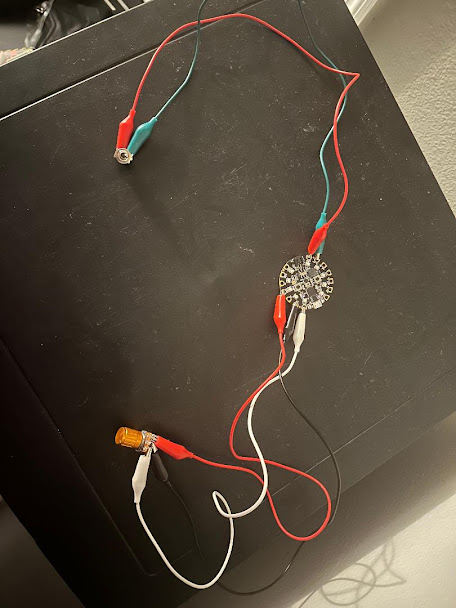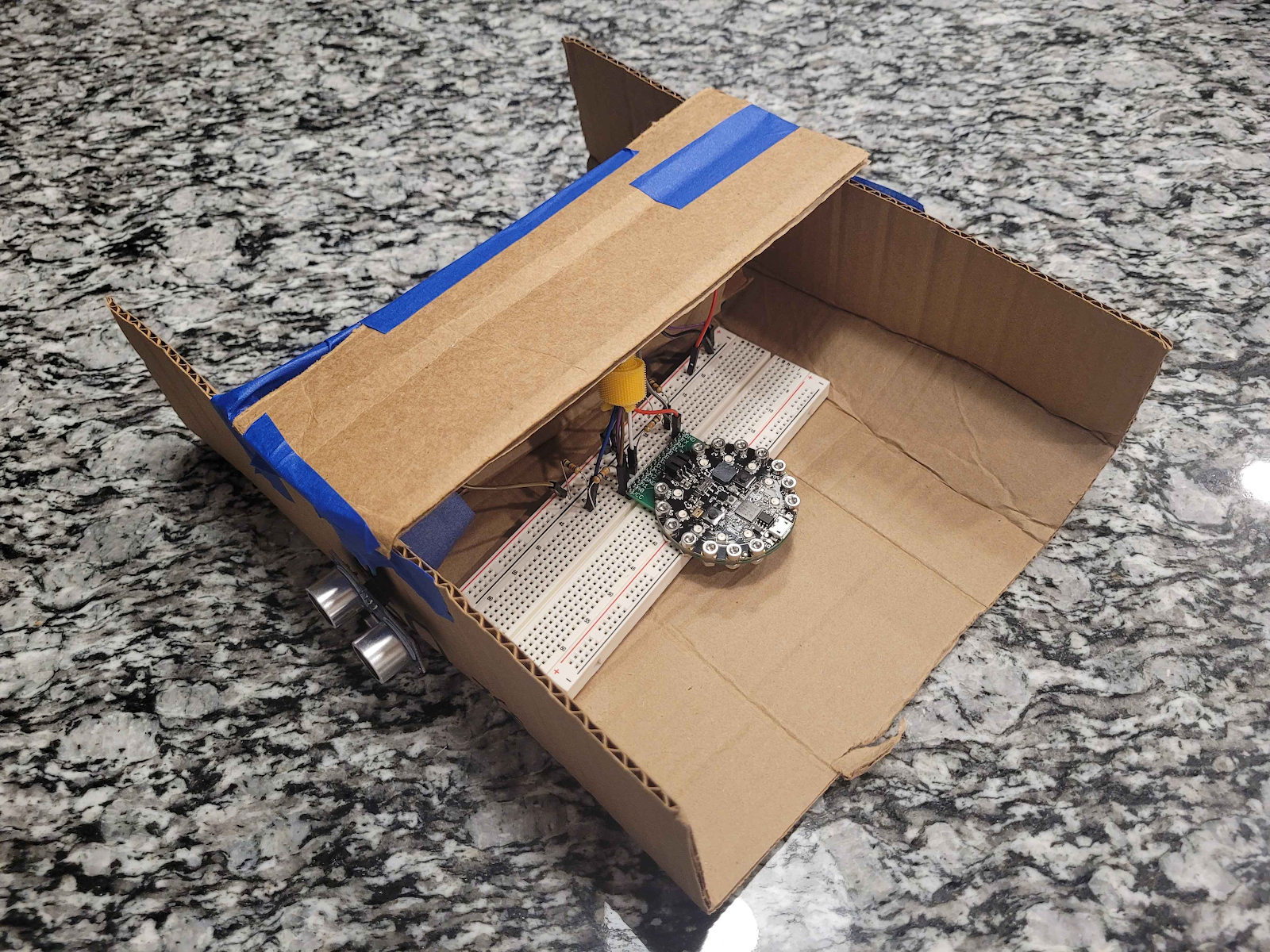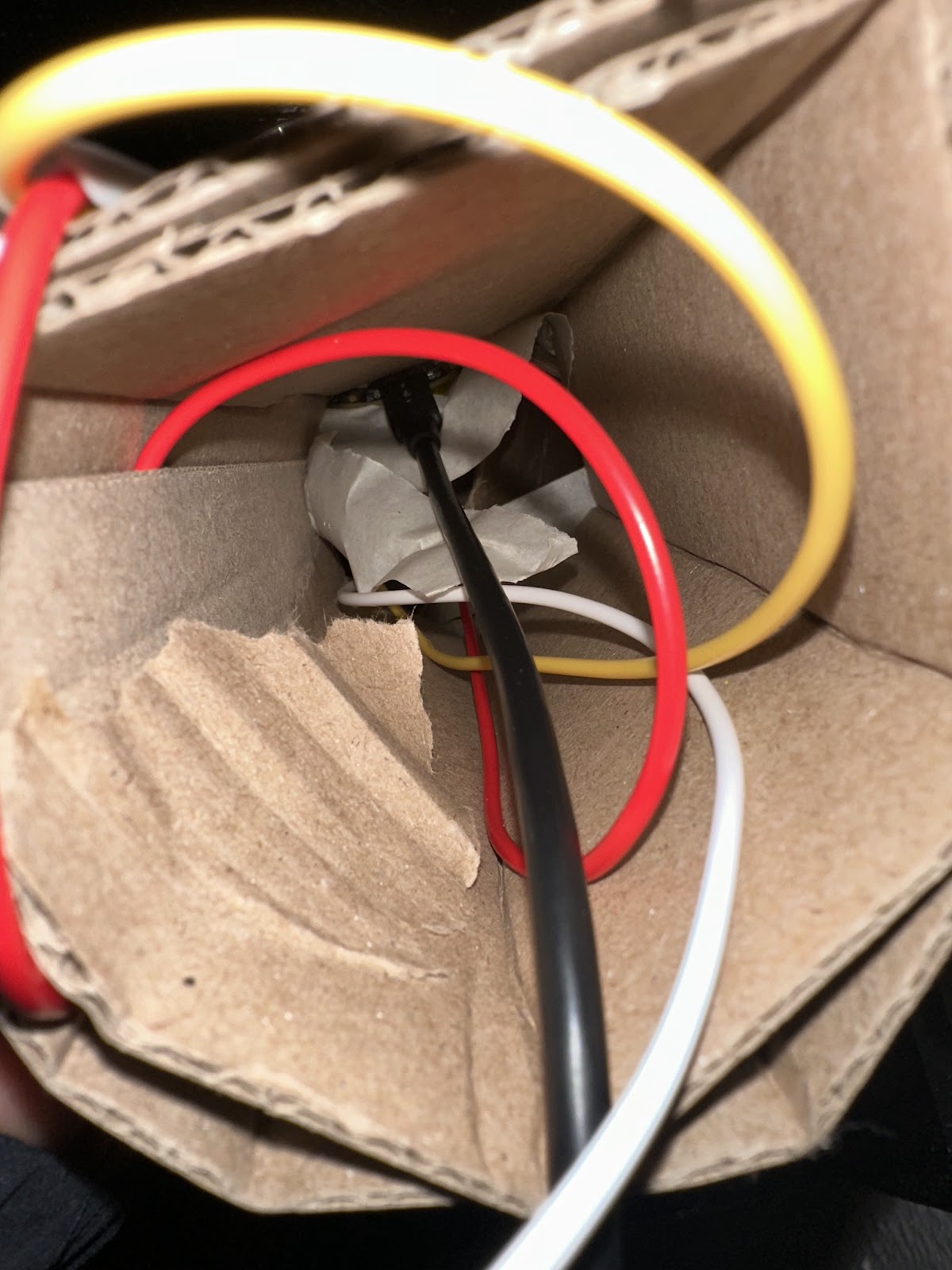Our scaffolding prototype is an unconventional Fall Guys Controller. The controller is made up of forward/backward and horizontal camera movement using a potentiometer, jump/dive movement using an Invensense, a switch to grab, and a 3D printed model of the character utilizing copper tape for left/right movement. The relationship between the controller and the game is the see saw like platform we built modeled after a game obstacle itself, as well as the 3D printed character from the game we utilize. The controller can be played by one person, but we learned that it might be easier and even more fun for 2 people to control the one character.
Peer Review Questions:
1. Is there any sensor on the controller you would switch out for a more convenient experience?
2. Would you have wired the circuit any differently? If so, how would you do it?
31 October 2024
Scaffolding: Prototype Review: Fall Guys Team 19
Scaffolding: Prototype Review Run and Gun Controller Team 16
Scaffolding: Prototype Review Jackson Sommer & Andrew Swanstrom Team 20
Minesweeper Controller Lo-Fi Prototype:
Conceptually, our controller is meant to mimic the precise and tedious hand movements of disarming a bomb. The cursor is operated with two dials. The left dial controls the horizontal movement, and the right dial controls the vertical movement. Flagging and detonating are operated with a series of pucks which are placed on a metal contact base. The "dig" puck has a metal contact running horizontally which activates a left click, while the "flag" puck has one running vertically to activate a right click. Using these four inputs, any given game of Minesweeper could be fully completed.
How could we theme the controller to better reflect the game of Minesweeper?
Even though the dial controls for the cursor are intended to be cumbersome, are they too cumbersome to facilitate fun gameplay?
Team 9 Prototype Review
Description
Our controller concept is to use a pair of glowsticks to play Hatsune Miku: Project DIVA MegaMix, a Nintendo Switch game that can be run on PC using emulation software. It's a rhythm game that utilizes button presses and joystick input, and these will be carried out on our controllers via motion input and a thumb slider respectively. We created a LoFi prototype for one of the glowsticks, which can respond to motion and the thumb slider through the LEDs. The conceptual relation of glowsticks to the game has to do with the custom of bringing glowsticks to live vocaloid concerts, which can be seen in the image below as an example.

Prototype Photos
 |
| Photo with the top part moved to show the inside |
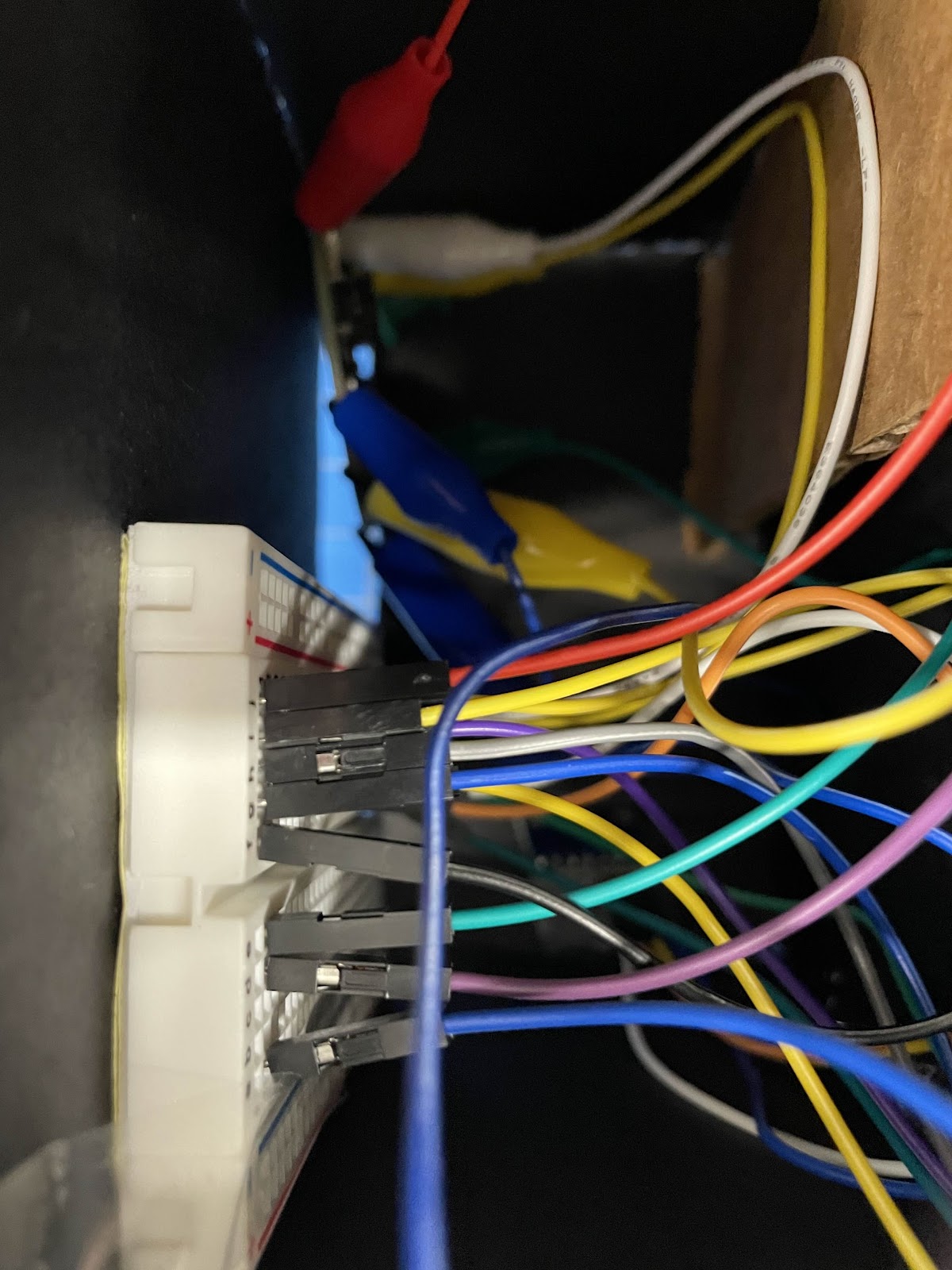 |
 |
Demonstration Video
Feedback questions
Team 8: Scaffolding - Prototype Review
Our controller prototype is made for the online game Fancy Pants. This game was released in 2006, and as a kid I always had a blast playing this game. It is a "free side-scrolling" game that was released on adobe flash, and it stood out to me as a kid due to its unique character movements. many of the other "free side-scrolling" games that i played on sites like Cool Math had the same smooth and fluid game play that Fancy Pants captured. Mario Kart Wii was released in 2008, and as a kid I was an avid Wii wheel controller user. I always imagined what it would be like to hook up the wheel aspect that Mario Kart offered to other games that I played, like Fancy Pants. That was my beginning inspiration for this controller. With this controller, I wanted to simulate the freedom a wheel gives its user while playing games, while also adding a unique way to make your character jump. My initial thought was to use voice to activate a jump, but after playing around with the ultra sonic sensor, I thought it would be cool to use your hand to simulate a jumping movement above the controller in order to make your character jump. I also wanted to simulate the feel of driving with the movement on the wheel, so the x-axis accelerometer in the circuit board controls the character's movement back and forth. I also programed the y-axis on the accelerometer, and when the controller is tilted upwards, the character will be able to enter doors, and when the controller is pointed downwards, the character will crouch. I also thought that the switch that was included in the pack we received for this class would add a nice touch to the controller, and elevate the overall look of the controller's front side. The switch is programmed to pause the game when flipped on and un-pause the game when flipped again.
Are there any other functions that we could add to the controller that would make the controller experience more enjoyable?
What is the weakest part of our controller as it stands?
30 October 2024
Team 13 - Toy Ship - currently not functional
Team 13 - Toy Ship - currently not functional
Our chosen prototype is a model ship with controls relating to the ship's in-game functions. X-axis control is performed by tilting the controller left and right, while Y-axis control is through a top-mounted potentiometer located where the engines would be. The firing control is situated where the pilot hatch would be and consists of a simple button that activates when the hatch is closed.
That is how it should be working.
Currently, there are some major issues. The physical part of the LoFi prototype is fine; the wiring is solid, and the board provides the proper space for the player to test the functionality of the controller. However, the main issue we are having is with the code; our prototype is primarily experiencing problems with the accelerometer. Despite various attempts, the controller keeps misreading and only registers the left arrow button for controls. The rest of the controls are sporadic; they usually read properly, but the accelerometer issue makes it hard to tell.
As for the video showing it in action, there is none since it doesn't work.
Here are the pictures of the LoFi circuitry:
Team 3 Prototype Review - Fireboy and Watergirl Controller
Fireboy and Watergirl Prototype Review
Our prototype is modeled after the main characters of the game. Right now we have the base model of what will be two controllers. The design includes a flip switch as their arm, and potentiometer as their eye. The flip switch is used to switch between the two characters so if one person wants to play both characters, they can. The potentiometer is used to move the characters left or right based on which way it is rotated. To make the characters jump, we used the microphone in the circuit playground to take the average sound levels in the room and have the character jump when there's a sudden spike above the average. What do you guys think? Should we make the controllers bigger? What can be improved upon in the design?
Team 11 - Prototype Review
Our controller prototype is designed to look like a broom, similar to the one the main character rides on in the game. The broom is full-size, so it can be ridden by the player in the same way. Moving the controller will move the character in the same direction, giving the player the experience of being the character. By shouting, you can activate the bomb, and by holding your hand over the distance sensor, you'll enter focus mode.
(Circuitry of the controller)
(Controller image)
(Video)
Question 1) Would it be better to try to make the character continue moving until the controller is moved to a neutral position, or would it be better to make the character only move while the controller is in motion, regardless of the controller’s current position?
Question 2) The current plan is to hide the circuitry in the broom’s bristles, with the wire coming out of the front of the broom’s handle. Would it be better to have the wire come out the back of the bristles? This would make the minimum wire length shorter, but could make the controller awkward to use because of the wire facing backwards.
Team 15: Rhythm Tambourine Prototype Review
Isaiah Maeztu and Matthew Cabrera
Here's our prototype Tambourine controller in a slightly more complete state. This controller is based on the minigame 'Tambourine' from Rhythm Heaven Fever, where the player must play follow a tambourine-playing-monkey's rhythm and play it back to them. This controller was chosen as it aligned the most with the simplicity and joy of playing Rhythm Heaven while letting the player give back to the game's music with their own beat!
1. What would seemingly be the smartest way to mount
something like this? Originally a 3D print was planned but I’d like other
suggestions and feedback
2. Besides the tap sensor, is there a good way to reduce
latency on inputs? Does the Circuit Playground have a way to easily adjust its polling
rate?
Team 10: Mimic Prototype Review
Crypt of the NecroDancer Mimic
Crypt of the NecroDancer is a game in which the player
traverses a dungeon to the rhythm of the music playing in the background. Our
prototype is high-fidelity: Our visual prototype consists of a 3D printed chest
body as well as foam teeth. The circuit is a breadboard, the Circuit
Playground, as well as two FSRs and a linear potentiometers. These analog
sensors are used for the 'mouth sores' and the tongue respectively. Our
aesthetic design is based on a Mimic, which is an iconic fantasy genre creature
that is also present in the game. Feedback Questions:
- Do you
agree that the aesthetics of the controller match the game well?
- How do the actual controls make you feel? Are they intuitive, do they gross you out, etc.
Team 12 Prototype Review
For our prototype of our alternative game controller, we made a glove for a simple fighting game. We are using a cardboard glove that is meant to represent a workout glove. Not only is a workout glove comfortable, but it is also provides a different approach that is not seen in conventional controllers. For how it works, there are flex sensors for the index and middle fingers. Bending the index finger will make the character punch, and bending the middle will make them kick. The accelerometer x on the Circuit Playground Express controls the left and right movement, and a shake function allows the player to jump. Combining these moves in certain sequences allows for two Special Moves (executed by inputting left, right, and punch/kick). Here’s our questions:
1. What can we improve on our design, even with an actual workout glove in mind?
2. Is there any other equipment that we can implement to make our controller even more interactive/intuitive?
Team 6: CupHead Controller Prototype
Below is our prototype for our CupHead controller in a crude cardboard cup. The controller itself consists of three main types of inputs for the game Cuphead: Accelerometer that will move the character left and right depending on which direction its tilted on the X axis and make the character jump when tilted up on the Y axis, the potentiometer when set to an analog value of 341-682 will switch weapons for the character, and a switch on the handle of the cup then when in the high or on position will give the input for constant shooting and when in the low or off position will stop the input. The controller itself is supposed to be themed around the game CupHead as its shaped like a cup and the idea of the controller being shaped like a cup will make it ergonomic and easy to hold. The inputs for the controls will probably be changed as we encountered some issues when testing and creating the prototype controller. My two main questions for feedback:
1. Does the design of the controller seem cohesive with it's inputs?
2. Are there any specific inputs that would make the controller better to use?
Team 5 - DK Hat Controller Prototype
Our prototype is a controller designed to resemble a hat, which serves as a collectible in the game Donkey Kong. This design choice reflects the game's aesthetic and reinforces player engagement. The controller utilizes sound input from a microphone to trigger actions, such as jumping, when the noise level exceeds a specific threshold. Additionally, ultrasonic sensors are integrated to detect proximity, allowing players to navigate left, right, forward, and backward in response to obstacles, echoing the classic gameplay mechanics of Donkey Kong.
Ideally, the hat not only acts as a controller but also embodies the spirit of the game, encouraging players to collect it throughout their adventure. Successful collection provides audio and visual feedback, enhancing the sense of achievement and motivating exploration.
HOWEVER, we've run into issues when transitioning our breadboard into our prototype, and our code which was functional before is nonfunctional now.
Questions for Peer Review
How can we further emphasize the Donkey Kong theme in the hat controller? Would adding a monkey graphic improve its visual appeal?
What additional features or functionalities could enhance user interaction and overall gameplay experience with this controller?
Team 7 - Prototype Review Bomberman
Our low fidelity prototype for our Bomberman controller allows the user to become the Bomberman while they are playing. The circuit playground is housed behind the front face which is connected to the potentiometer, switches, light sensor, and ultrasonic sensor. This controller takes the shape of a bomb and lets you be in control, the potentiometer controls left and right directional movement while both the switches control up and down movement respectively (top switch goes up, bottom switch goes down). Since we want the player to become the Bomberman while they play, you are able to “light” the fuse by using a bright light, like a flashlight, on top of the bomb to activate the circuit playground's light sensor, doing this will place a bomb where you are standing. If you are able to last long enough to gain a specific power up, you will be able to motion near the top of the fuse with your hand this will instantly detonate your placed bomb, this is achieved by choosing the range on the ultrasonic range sensor to detect a button press if you are within that range in the real world.
1. Would there be a more efficient way to connect external sensors and wires to the circuit playground?
2. Do you think that the design and external sensors of the controller make the controls intuitive and cohesive?
Prototype Review: Angry Birds Team 4
Using a potentiometer, light sensor, and tap detection, our low-fidelity prototype for the Angry Birds Classic motion-based controller brings the slingshot mechanic to life. The potentiometer allows players to adjust the launch angle and power, simulating the slingshot’s pullback effect. Once the player sets their aim, the light sensor registers a “click” or release action to launch the bird, creating a tactile feel similar to the original game. Tap detection is also included for activating special abilities, like the bird’s split shot, offering an engaging control experience without the need for the usual control inputs.
Peer Review Questions
Does the potentiometer effectively capture the pullback motion of the slingshot, or could another sensor enhance this effect?
Is using the light sensor to register “clicks” an natural approach, or could ambient light impact gameplay?
Scaffolding: Prototype Review - Team 17
Jordan Oliver & Gary Hazelgren
The controller prototype for the game "Run" is an innovative alternative controller designed to enhance your experience through intuitive physical interactions. The controls include a flex sensor, a sound sensor and a distance sensor. The flex sensor is used to detect jumps, responding to the player's bending their wrist, the sound sensor is used for left movement and the distance sensor is used for right movement. Conceptually, the design aims to create a more inclusive gaming experience, allowing players with limited dexterity to participate actively. By translating physical gestures into in-game actions, the prototype bridges the gap between traditional controller interfaces and player capabilities, making the game more accessible.
Feedback Questions:
How effective do you think the gloves will be in providing precise control without causing frustration during gameplay?
Are there any potential improvements or alternative sensors you would recommend to enhance the prototype’s responsiveness and overall user experience?
(Photo of controller)
(Photo of circuit)
(Video of prototype)











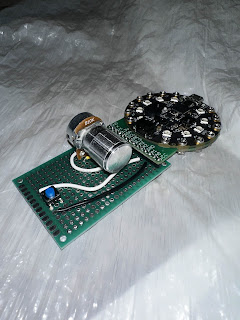








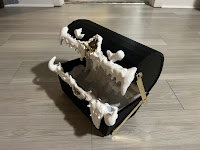

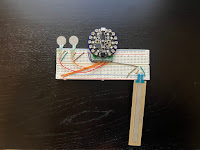
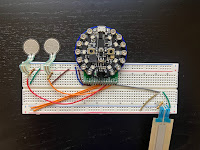



.jfif)
